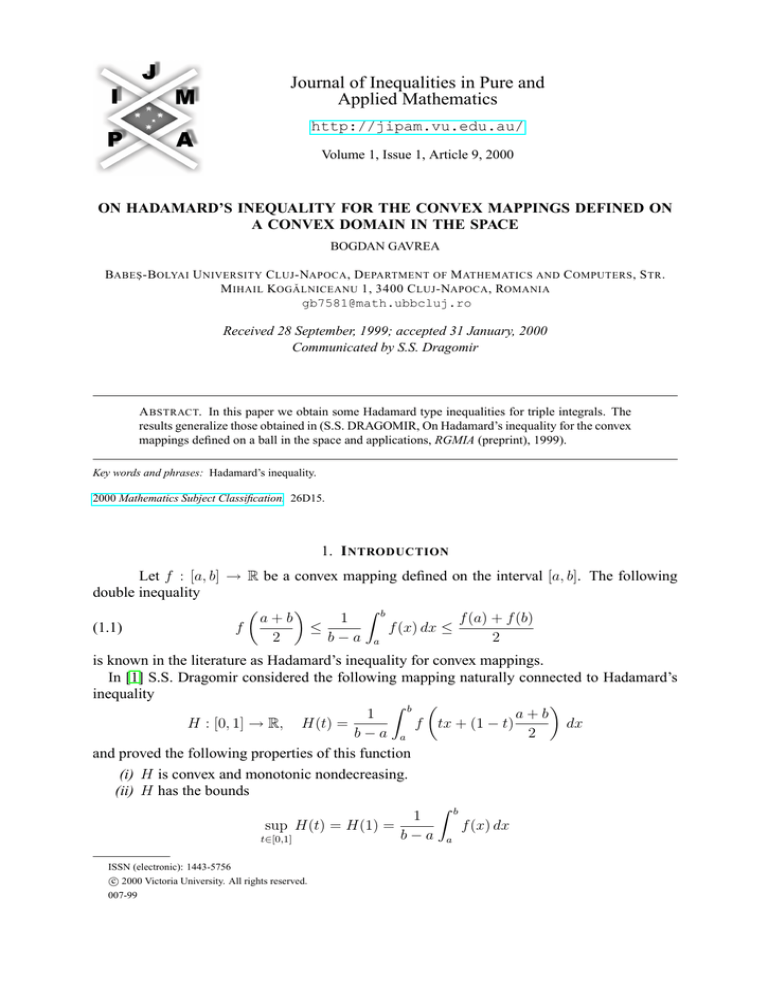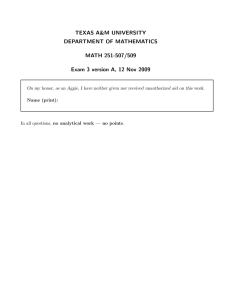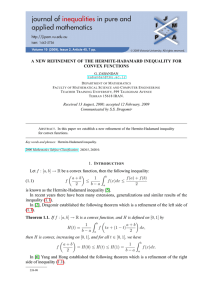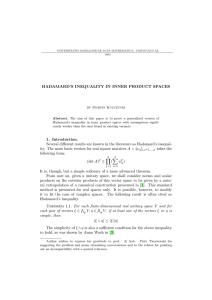
Journal of Inequalities in Pure and
Applied Mathematics
http://jipam.vu.edu.au/
Volume 1, Issue 1, Article 9, 2000
ON HADAMARD’S INEQUALITY FOR THE CONVEX MAPPINGS DEFINED ON
A CONVEX DOMAIN IN THE SPACE
BOGDAN GAVREA
BABE Ş -B OLYAI U NIVERSITY C LUJ -NAPOCA , D EPARTMENT OF M ATHEMATICS AND C OMPUTERS , S TR .
M IHAIL KOG ĂLNICEANU 1, 3400 C LUJ -NAPOCA , ROMANIA
gb7581@math.ubbcluj.ro
Received 28 September, 1999; accepted 31 January, 2000
Communicated by S.S. Dragomir
A BSTRACT. In this paper we obtain some Hadamard type inequalities for triple integrals. The
results generalize those obtained in (S.S. DRAGOMIR, On Hadamard’s inequality for the convex
mappings defined on a ball in the space and applications, RGMIA (preprint), 1999).
Key words and phrases: Hadamard’s inequality.
2000 Mathematics Subject Classification. 26D15.
1. I NTRODUCTION
Let f : [a, b] → R be a convex mapping defined on the interval [a, b]. The following
double inequality
Z b
a+b
1
f (a) + f (b)
(1.1)
f
≤
f (x) dx ≤
2
b−a a
2
is known in the literature as Hadamard’s inequality for convex mappings.
In [1] S.S. Dragomir considered the following mapping naturally connected to Hadamard’s
inequality
Z b 1
a+b
H : [0, 1] → R, H(t) =
f tx + (1 − t)
dx
b−a a
2
and proved the following properties of this function
(i) H is convex and monotonic nondecreasing.
(ii) H has the bounds
Z b
1
sup H(t) = H(1) =
f (x) dx
b−a a
t∈[0,1]
ISSN (electronic): 1443-5756
c 2000 Victoria University. All rights reserved.
007-99
2
B OGDAN G AVREA
and
inf H(t) = H(0) = f
t∈[0,1]
a+b
2
.
In the recent paper [2], S.S. Dragomir gave some inequalities of Hadamard’s type for convex
functions defined on the ball B(C, R), where
C = (a, b, c) ∈ R3 ,
R>0
and
B(C, R) := {(x, y, z) ∈ R3 | (x − a)r + (y − b)2 + (z − c)2 ≤ R2 }
More precisely he proved the following theorem.
Theorem 1.1. Let f : B(C, R) → R be a convex mapping on the ball B(C, R). Then we have
the inequality
ZZZ
1
(1.2)
f (a, b, c) ≤
f (x, y, z) dxdydz
v(B(C, R))
B(C,R)
ZZ
1
≤
f (x, y, z) dσ
σ(B(C, R)) S(C,R)
where
S(C, R) := {(x, y, z) ∈ R2 | (x − a)2 + (y − b)2 + (z − c)2 = R2 }
and
v(B(C, R)) =
4πR3
,
3
σ(B(C, R)) = 4πR2 .
In [2] S.S. Dragomir considers, for a convex mapping f defined on the ball B(C, R), the
mapping H : [0, 1] → R given by
ZZZ
1
H(t) =
f (t(x, y, z) + (1 − t)C) dxdydz.
v(B(C, R))
B(C,R)
The main properties of this mapping are contained in the following theorem.
Theorem 1.2. With the above assumption, we have
(i) The mapping H is convex on [0, 1].
(ii) H has the bounds
inf H(t) = H(0) = f (C)
(1.3)
t∈[0,1]
and
(1.4)
1
sup H(t) = H(1) =
v(B(C, R))
t∈[0,1]
ZZZ
f (x, y, z) dxdydz.
B(C,R)
(iii) The mapping H is monotonic nondecreasing on [0, 1].
In this paper we shall give a generalization of the Theorem 1.2 for a positive linear functional defined on C(D), where D ⊂ Rm (m ∈ N∗ ) is a convex domain. We shall give also a
generalization of the Theorem 1.1.
J. Ineq. Pure and Appl. Math., 1(1) Art. 9, 2000
http://jipam.vu.edu.au/
O N H ADAMARD ’S I NEQUALITY FOR THE C ONVEX M APPINGS
3
2. R ESULTS
Let D ⊂ Rm be a convex domain and A : C(D) → R be a given positive linear functional
such that A(e0 ) = 1, where e0 (x) = 1, x ∈ D. Let x = (x1 , . . . , xm ) be a point from D we
note by pi , i = 1, 2, . . . , m the function defined on D by
pi (x) = xi ,
i = 1, 2, . . . , m
and by ai , i = 1, 2, . . . , m the value of the functional A in pi , i.e.
A(pi ) = ai ,
i = 1, 2, . . . , m.
In addition, let f be a convex mapping on D. We consider the mapping H : [0, 1] → R
associated with the function f and given by
H(t) = A(f (tx + (1 − t)a))
where a = (a1 , a2 , . . . , am ) and the functional A acts analagous to the variable x.
Theorem 2.1. With above assumption, we have
(i) The mapping H is convex on [0, 1].
(ii) The bounds of the function H are given by
inf H(t) = H(0) = f (a)
(2.1)
t∈[0,1]
and
sup H(t) = H(1) = A(f ).
(2.2)
t∈[0,1]
(iii) The mapping H is monotonic nondecreasing on [0, 1].
Proof. (i) Let t1 , t2 ∈ [0, 1] and α, β ≥ 0 with α + β = 1. Then we have
H(αt1 + βt2 ) = A[f ((αt1 + βt2 )x + (1 − (αt1 + βt2 ))a)]
= A[f (α(t1 x + (1 − t1 )a) + β(t2 x + (1 − t2 )a))]
≤ αA[f (t1 x + (1 − t1 )a)] + BA[f (t2 x + (1 − t2 )a)]
= αH(t1 ) + βH(t2 )
which proves the convexity of H on [0, 1].
(ii) Let g be a convex function on D. Then there exist the real numbers A1 , A2 , . . . , Am such
that
(2.3)
g(x) ≥ g(a) + (x1 − a1 )A1 + (x2 − a2 )A2 + · · · + (xm − am )Am
for any x = (x1 , . . . , xm ) ∈ D.
Using the fact that the functional A is linear and positive, from the inequality (2.3) we obtain
the inequality
A(g) ≥ g(a).
(2.4)
Now, for a fixed number t, t ∈ [0, 1] the function g : D → R defined by
g(x) = f (tx + (1 − t)a)
is a convex function. From the inequality (2.4) we obtain
A(f (tx + (1 − t)a)) ≥ f (ta + (1 − t)a) = f (a)
or
H(t) ≥ H(0)
for every t ∈ [0, 1], which proves the equality (2.1).
J. Ineq. Pure and Appl. Math., 1(1) Art. 9, 2000
http://jipam.vu.edu.au/
4
B OGDAN G AVREA
Let 0 ≤ t1 < t2 ≤ 1. By the convexity of the mapping H we have
H(t1 ) − H(0)
H(t2 ) − H(t1 )
≥
≥ 0.
t2 − t1
t1
So the function H is a nondecreasing function and H(t) ≤ H(1). The theorem is proved.
Remark 2.1. For m = 1, D = [a, b] and
1
A(f ) =
b−a
Z
b
f (x) dx
a
the function H is the function which was considered in the paper [1].
Remark 2.2. For m = 3 and D = B(C, R) and
ZZZ
1
A(f ) =
f (x, y, z) dxdydz
v(B(C, R))
B(C,R)
a being C, the function H is the functional from the Theorem 1.2.
Let D be a bounded convex domain from R3 with a piecewise smooth boundary S. We define
the notation
ZZ
σ :=
dS,
S
ZZ
1
a1 :=
x dS,
σ
S
ZZ
1
a2 :=
y dS,
σ
S
ZZ
a3 :=
z dS,
S
ZZZ
v :=
f (x, y, z) dxdydz.
V
Let us assume that the surface S is oriented with the aid of the unit normal h directed to the
exterior of D
h = (cos α, cos β, cos γ).
The following theorem is a generalization of the Theorem 1.1.
Theorem 2.2. Let f be a convex function on D. With the above assumption we have the following inequalities
ZZ
ZZ
(2.5) v
f ds − σ
[(a1 − x) cos α + (a2 − y) cos β + (a3 − z) cos γ]f (x, y, z)dS
S
S
ZZZ
≥ 4σ
f (x, y, z) dxdydz
D
and
ZZZ
f (x, y, z) dxdydz ≥ f (xσ , yσ , zσ )v,
(2.6)
D
where
1
xσ =
v
ZZZ
x dxdydz,
D
J. Ineq. Pure and Appl. Math., 1(1) Art. 9, 2000
1
yσ =
v
ZZZ
y dxdydz,
D
1
zσ =
v
ZZZ
z dxdydz.
D
http://jipam.vu.edu.au/
O N H ADAMARD ’S I NEQUALITY FOR THE C ONVEX M APPINGS
Proof. We can suppose that the function f has the partial derivatives
5
∂f ∂f ∂f
,
,
and these are
∂x ∂y ∂z
continuous on D.
For every point (u, v, w) ∈ S and (x, y, z) ∈ D the following inequality holds:
∂f
∂f
∂f
(x, y, z)(u − x) + (x, y, z)(v − y) + (x, y, z)(w − z).
∂x
∂y
∂z
From the inequality (2.7) we have
ZZ
∂f
(2.8)
f (x, y, z) dS ≥ f (x, y, z)σ +
(x, y, z)(a1 − x)σ
∂x
S
∂f
∂f
+
(x, y, z)(a2 − y)σ +
(x, y, z)(a3 − z)σ.
∂y
∂z
The above inequality leads us to the inequality
ZZ
ZZZ
(2.9) v
f (x, y, z) dS ≥ σ
f (x, y, z) dxdydz
S
D
#
ZZZ "
∂
∂
∂
+σ
((a1 − x)f (x, y, z)) + ((a2 − y)f (x, y, z)) + ((a3 − z)f (x, y, z)) dxdydz
∂y
∂z
D ∂x
ZZZ
+ 3σ
f (x, y, z) dxdydz.
(2.7) f (u, v, w) ≥ f (x, y, z) +
D
Using the Gauss-Ostrogradsky’ theorem we obtain the equality
ZZZ "
∂
∂
(2.10)
((a1 − x)f (x, y, z) +
((a2 − y)f (x, y, z))
∂y
D ∂x
#
∂
+ ((a3 − z)f (z, y, z) dxdydz
∂z
ZZ
=
[(a1 − x) cos α + (a2 − y) cos β + (a3 − z) cos γ]f (x, y, z) dS.
S
From the relations (2.9) and (2.10) we obtain the inequality (2.4). The inequality (2.6) is the
inequality (2.4) for the functional
ZZZ
f (x, y, z) dxdydz
D
Z
Z
Z
A(f ) =
.
dxdydz
D
Remark 2.3. For D = B(C, R) we have
(a1 , a2 , a3 ) = C
and
x − a1
y − a2
z − a3
, cos β =
, cos γ =
.
R
R
R
In this case the inequality (2.4) becomes
ZZZ
ZZ
σ
f (x, y, z) dxdydz ≤ v
f (x, y, z) dσ.
cos α =
B(C,R)
J. Ineq. Pure and Appl. Math., 1(1) Art. 9, 2000
S(C,R)
http://jipam.vu.edu.au/
6
B OGDAN G AVREA
R EFERENCES
[1] S.S. DRAGOMIR, A mapping in connection to Hadamard’s inequality, An. Ostro. Akad. Wiss. Math.Natur. (Wien), 128 (1991), 17-20.
[2] S.S. DRAGOMIR, On Hadamard’s inequality for the convex mappings defined on a ball
in the space and applications, RGMIA (preprint), 1999. [ONLINE] Available online at
http://rgmia.vu.edu.au/Hadamard.html#HHTICF
J. Ineq. Pure and Appl. Math., 1(1) Art. 9, 2000
http://jipam.vu.edu.au/







